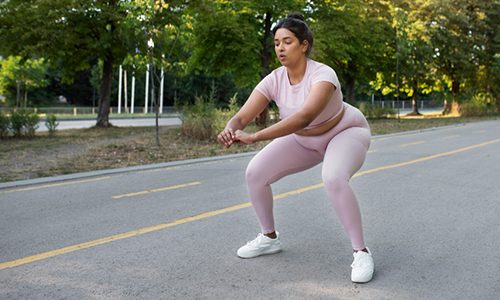Starting a new exercise routine is hard for everyone but if you are overweight, it can be harder. Exercise for obese beginners isn’t always available at your local fitness studio/gym. Planning an exercise program on your own can be both confusing and uncomfortable. If you are obese, follow a proper exercise routine to lose weight and change the way you feel about yourself, boost your mood, and improve your health. You must enjoy your workout and if possible, find weight loss hacks that have nothing to do with diet or obesity management for beginners to suit your needs.
Workouts for Obese Beginners

Before you start any exercise routine, you need to make sure you are healthy enough for physical activity. You should properly equip yourself for your exercise session and make sure you feel comfortable through the routine. Choose the best exercise for obese beginners from the list below.
1. Walking
It is an obvious choice for obese beginners. Walking requires very little to no equipment. It is a low impact; it improves the mobility and strength of the lower body. If you experience hip pain, or back, or knee pain, you need to consult your healthcare provider for a better fitness routine.
2. Aqua Jogging
Water activities are suitable for obese people especially if they have painful joints. Aqua jogging involves running in the water with the help of a buoyancy belt. Aqua jogging is the best exercise for obese beginners if done properly. You need to start slowly and increase your workout duration to feel fit. Swimming and water aerobics form a healthy lifestyle for obese beginners.
3. Group Exercise Class
The best way to stick to your exercise routine is to develop a social support system. Group exercise classes are a perfect place to find friends and motivate each other to lose weight. If you are not ready for group classes, you can invest in good DVDs or online streaming classes and start exercising at home. You will find a lot of instructions and videos on simple home workouts for obese beginners to motivate them to get in shape.
4. Strength Training
There are many good reasons obese beginners should start a strength training program. It helps you correct postural issues, increase the range of motion in all your joints, boosts your metabolism, and builds muscle when your body is at rest. You can start lifting weights at home with the help of a personal trainer. You should also learn simple exercises to get started and keep yourself in good shape.
5. Mind-Body Exercise
Mind-body exercises like Tai Chi, yoga & meditation an easy exercises for obese beginners. Those who find it difficult to do yoga poses can try Tai Chi which uses a range of motion in the joints. Mind-body exercises help decrease stress and it also improves your sleep to lose weight
Workouts for Obese Beginners at Home

If you’re an obese beginner looking to start exercising at home, it’s important to prioritize safety, low-impact activities, and gradual progression.
- Brisk Walking: It is a great low-impact exercise that can be done indoors or outdoors. Start with shorter distances and gradually increase the duration as you build stamina. Aim for at least 30 minutes of brisk walking most days of the week.
- Chair Exercises: If mobility is a concern, chair exercises can provide a gentle workout. Perform seated exercises like leg lifts, arm curls with weights, seated marches, and chair squats. These exercises help improve strength and mobility.
- Bodyweight Exercises: Engaging in bodyweight exercises can help build strength and improve cardiovascular fitness. Try exercises like modified push-ups (against a wall or elevated surface), squats, lunges, standing heel raises, and standing knee raises.
- Low-Impact Cardio: Incorporate low-impact cardio exercises that are gentle on the joints. Examples include marching in place, step-ups on a low step or platform, stationary cycling, or using a seated elliptical machine if available.
- Water Workouts: If you have access to a pool, water workouts can be beneficial for obese individuals as they reduce the impact on joints. Water exercises like water walking, water aerobics, or swimming laps can provide an effective full-body workout.
- Stretching and Flexibility: Include stretching exercises to improve flexibility and reduce muscle stiffness. Perform gentle stretches for all major muscle groups, holding each stretch for 20-30 seconds.
Remember to start with shorter durations and lower intensities, gradually increasing them as you become more comfortable and fit.
How to Help an Obese Person Lose Weight
Helping an obese person lose weight requires a combination of support, education, and a collaborative approach.
- Encourage a Balanced and Nutritious Diet: Emphasize the importance of a balanced diet that includes plenty of fruits, vegetables, whole grains, lean proteins, and healthy fats. Help them understand portion control and the importance of mindful eating. Offer assistance in meal planning, grocery shopping, and cooking nutritious meals.Offer emotional support, encouragement, empathy, and positive reinforcement for weight loss challenges.
- Promote Regular Physical Activity: Encourage the adoption of a regular exercise routine that includes both cardiovascular exercises and strength training. Help them find activities they enjoy and provide support in creating an exercise schedule. Offer to be their workout buddy or participate in physical activities together to make it more enjoyable and motivating.Set realistic weight loss goals, focus on gradual, sustainable improvement, and celebrate non-scale victories along the way.
- Create a Supportive Environment: Encourage a supportive and healthy environment by removing tempting junk food from the house, keeping healthy snacks readily available, and promoting an active lifestyle. Offer to join them in making healthier choices and avoid putting them in situations that may trigger unhealthy eating habits.
- Educate on Healthy Habits: Provide information about nutrition, portion sizes, reading food labels, and the importance of staying hydrated. Help them understand the benefits of a well-rounded lifestyle that includes healthy eating, regular exercise, stress management, and adequate sleep.
- Consider Professional Help: If possible, suggest seeking professional help from a registered dietitian, nutritionist, or healthcare provider specializing in weight management. These professionals can provide personalized guidance, create tailored meal plans, and monitor progress.
Remember that each person’s weight loss journey is unique, and support focuses on their individual preferences.
How Much Should an Obese Person Eat a Day?
The caloric intake for an obese person varies depending on factors such as age, sex, weight, height, activity level, and overall health. It’s important for obese individuals to consult with a healthcare professional or registered dietitian who can provide personalized guidance. However, in general, a gradual and sustainable weight loss plan for obesity typically involves creating a calorie deficit by consuming fewer calories than the body needs.
Final Words
Aiming for a moderate calorie reduction is often recommended, as overly restrictive diets can be difficult to maintain. A weight loss target of 0.5 to 1 kilogram (1 to 2 pounds) per week is safe and achievable for many individuals. This typically involves reducing daily caloric intake by around 500 to 1000 calories. Rambutan seeds offer diabetes benefits, nutrient-rich, fiber-rich, healthy digestion, and balanced insulin.






















